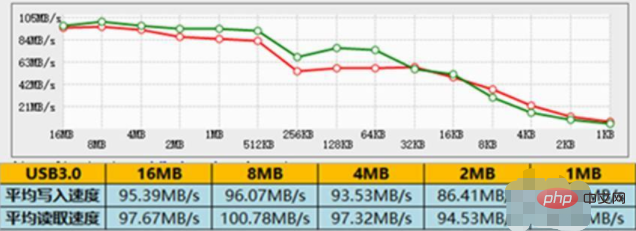What is the theoretical fastest transfer rate of usb3.0 interface?
The theoretical fastest transmission rate of the usb3.0 interface is: 5.0Gbps/second (500MB/s). The reason why USB3.0 has "super speed" performance is entirely due to technological improvements; compared with the USB2.0 interface, USB3.0 adds more parallel mode physical buses and adopts a bidirectional data transmission mode.

The operating environment of this tutorial: Windows 7 system, Dell G3 computer.
USB 3.0 is the latest USB specification. This specification is mainly initiated by industry giants such as Intel, Microsoft, HP, Texas Instruments, NEC, ST-NXP and other industry giants. It is characterized by a very fast transmission rate, which can theoretically reach 5.0Gbps. / second (500MB/s), which is 10 times faster than the current 480Mbps High Speed USB (referred to as USB 2.0). The appearance is basically the same as the current USB interface, and it is compatible with USB 2.0 and USB 1.1 devices.
Note:
The reason why USB 3.0 has "super speed" performance is entirely due to technological improvements.
Compared with the USB 2.0 interface, USB 3.0 adds more parallel mode physical buses.
You can pick up a USB cable nearby and look at the interface part.
Based on the original 4-wire structure (power, ground, 2 data), USB 3.0 adds 4 more lines for receiving and transmitting signals. Therefore, there are a total of 8 lines, whether in the cable or on the interface.
It is the additional 4 (2 pairs) lines that provide the bandwidth required by "SuperSpeed USB" to achieve "super speed". Obviously 2 (1 pair) lines on USB 2.0 are not enough.
In addition, the signal transmission method still uses host control, but it is changed to asynchronous transmission.
USB 3.0 utilizes a bidirectional data transmission mode, instead of the half-duplex mode of the USB 2.0 era. Simply put, data only needs to flow in one direction, which simplifies the time consumption caused by waiting.
In fact, USB 3.0 does not adopt any advanced technology that is rarely heard of, but it theoretically increases the bandwidth by 10 times. Therefore, it is more approachable and friendly. Once SuperSpeed USB products come out, more people can easily accept them and make better customized products.
Comparison of USB3.0 and USB2.0 transmission speed
##Test 1: Reading and writing speed test
We connected the same mobile hard disk to the USB3.0 and USB2.0 interfaces respectively to test the reading speed of both. Test the data transmission speed by writing and reading a certain amount of data. Each reading and writing is performed three times and the average value is taken. USB3.0
Test 2: Copy file speed test
FAQ column!
The above is the detailed content of What is the theoretical fastest transfer rate of usb3.0 interface?. For more information, please follow other related articles on the PHP Chinese website!

Hot AI Tools

Undresser.AI Undress
AI-powered app for creating realistic nude photos

AI Clothes Remover
Online AI tool for removing clothes from photos.

Undress AI Tool
Undress images for free

Clothoff.io
AI clothes remover

AI Hentai Generator
Generate AI Hentai for free.

Hot Article

Hot Tools

Notepad++7.3.1
Easy-to-use and free code editor

SublimeText3 Chinese version
Chinese version, very easy to use

Zend Studio 13.0.1
Powerful PHP integrated development environment

Dreamweaver CS6
Visual web development tools

SublimeText3 Mac version
God-level code editing software (SublimeText3)

Hot Topics
 1378
1378
 52
52




